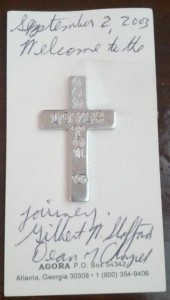Reconciliation is the process of restoring friendly relationships between individuals and communities. It is something that is desperately needed in today’s world, from the streets of Ferguson to the mountains of Afghanistan, from the hallways of public schools to the pews of local churches, from county courthouses to family living rooms.
Reconciliation is a one-word description of the work of God through Jesus Christ. This passage from 2 Corinthians is very important:
Therefore, if anyone is in Christ, he is a new creation; the old has gone, the new has come! All this is from God, who reconciled us to himself through Christ and gave us the ministry of reconciliation: that God was reconciling the world to himself in Christ, not counting men’s sins against them. And he has committed to us the message of reconciliation. We are therefore Christ’s ambassadors, as though God were making his appeal through us. We implore you on Christ’s behalf: Be reconciled to God. God made him who had no sin to be sin for us, so that in him we might become the righteousness of God.
(2 Corinthians 5:17-21 NIV)
You might recognize the last verse as the inspiration for the opening words of “Jesus Messiah,” a worship song that we sing with some regularity at Mt. Haley.
Biblical reconciliation – making things right between God and us, and between each other – is the theme of the Anderson University School of Theology, where I am currently working on a Doctor of Ministry degree. In mid-April, I spent a week on Anderson’s campus taking forty hours’ worth of intensive classes for my spring course; the emphasis of this course was all on biblical reconciliation.
In preparation for this course, I read a number of books and articles, as with any graduate-level class. One book in particular stood out: “Mobilizing for the Common Good: the Lived Theology of John M. Perkins.” This book is an anthology of essays about John M. Perkins, an African-American Christian leader who has worked tirelessly in his 85 years of life for the causes of God’s kingdom, social justice, and community development. Perkins founded the Christian Community Development Association in the late 1980s and has promoted “relocation, reconciliation, and redistribution” as three Christian principles that can transform local communities.
I did not know anything about John Perkins before taking this class. Our discussions about his urban ministry efforts reminded me of our time in inner-city Indianapolis. In a way, the issues facing urban areas – issues like poverty, drug abuse, homes in disrepair, and socio-economic segregation – appear in rural settings like ours, as well. This class gave me much food for thought.
On Friday, on my way home after classes ended, I stopped in nearby Muncie to have dinner with an old college friend of mine. She and her husband live in a depressed neighborhood with their two young children. I had not seen this friend for about a decade, so we had quite a bit of catching up to do.
I asked my friend about her church life, which I know is very important to her. She talked about how the core group of church leaders (including her family) moved into that Muncie neighborhood several years ago as a stabilizing force in a very transitional community. She spoke about how everything their church does is aimed toward the goal of reconciliation. And then she asked me a question that made me do a double-take:
“Have you ever read anything about John Perkins?”
Why, yes, actually I had just spent that entire week learning about John Perkins. And now I was sitting in the home of a friend whose church was putting into practice the principles of Perkins’s ministry.
It was like reading a book about baseball and then being thrust into the dugout of the home team during a regular-season game.
What kinds of reconciliation are needed in our community today? How can we partner with God (and with others) to accomplish this great work? It is, after all, the work that Christ left us to do in this world.
